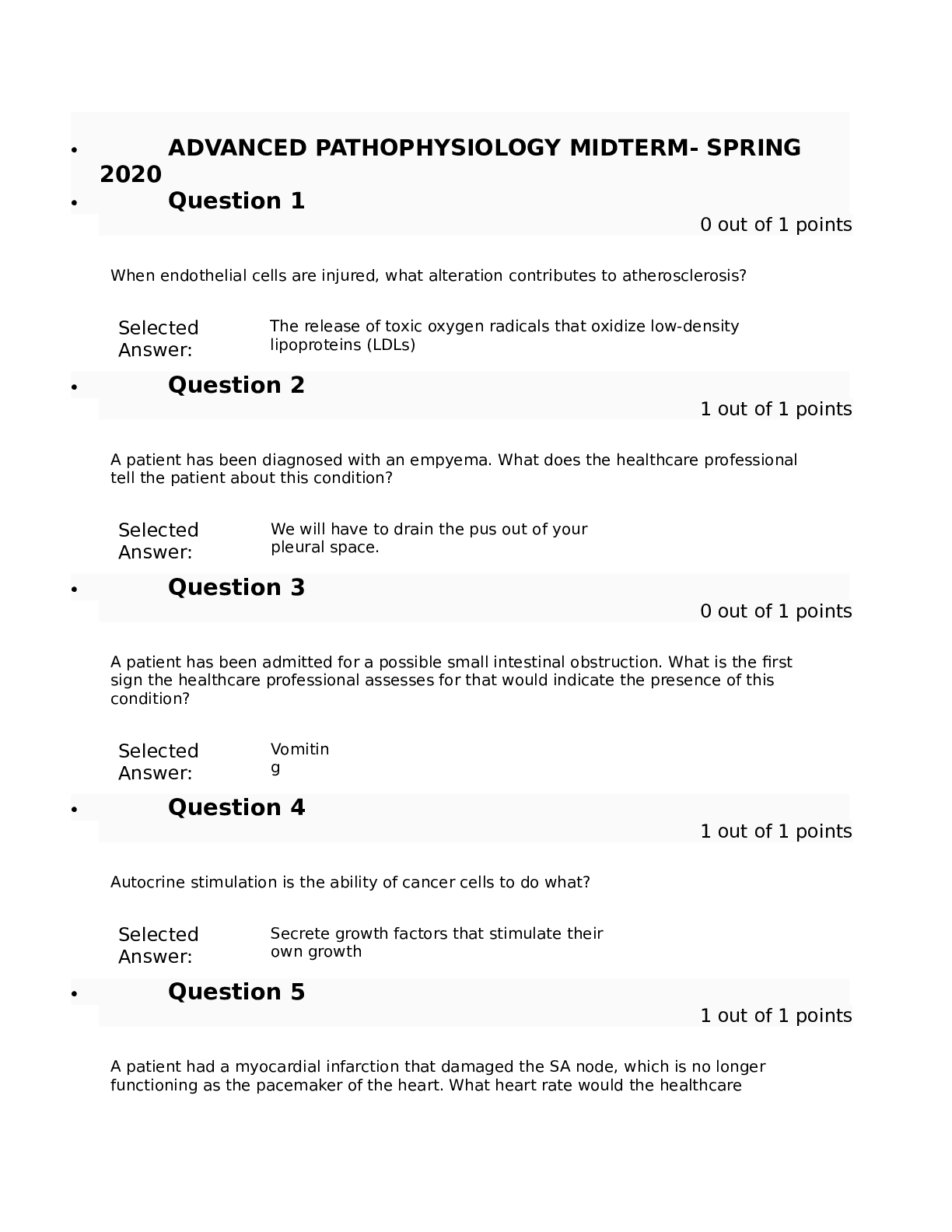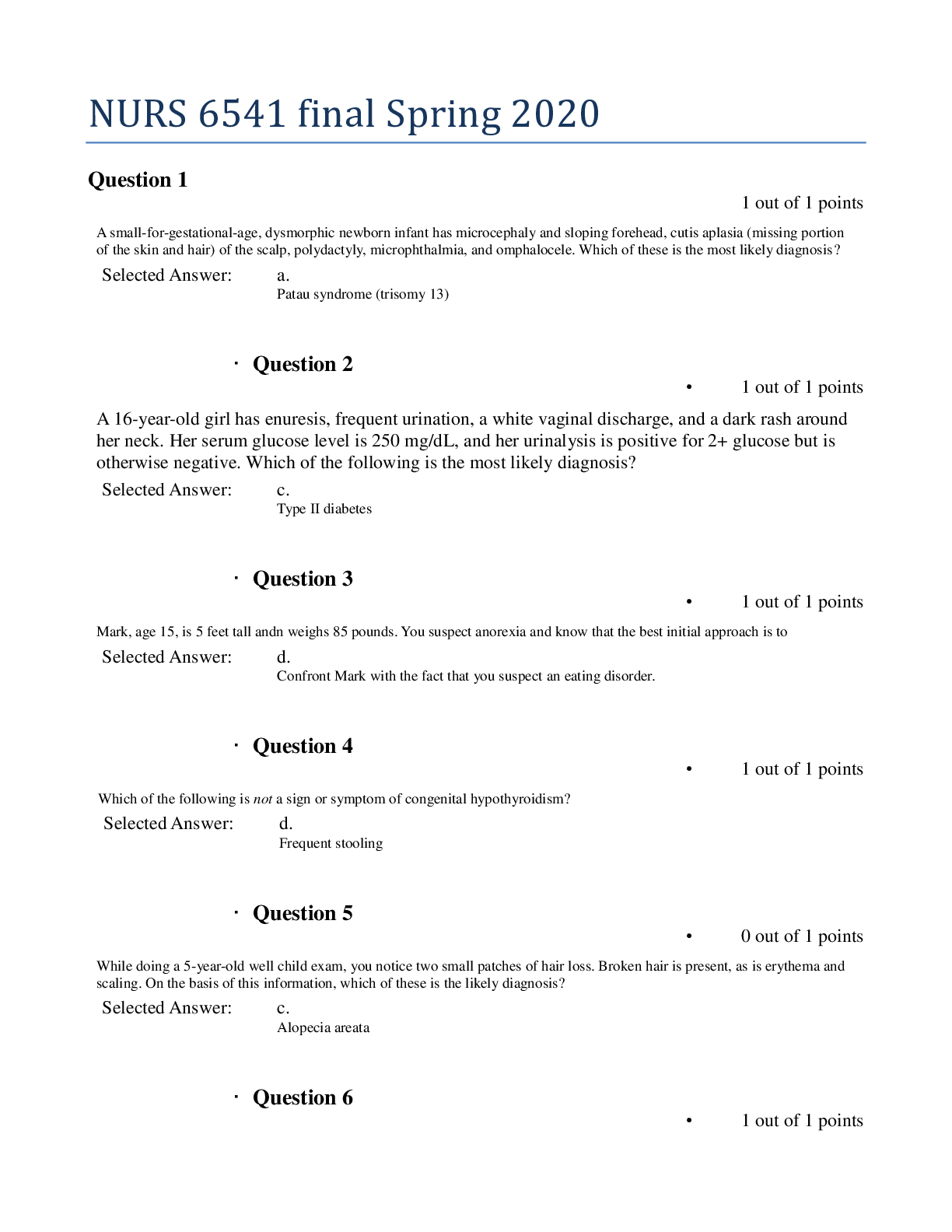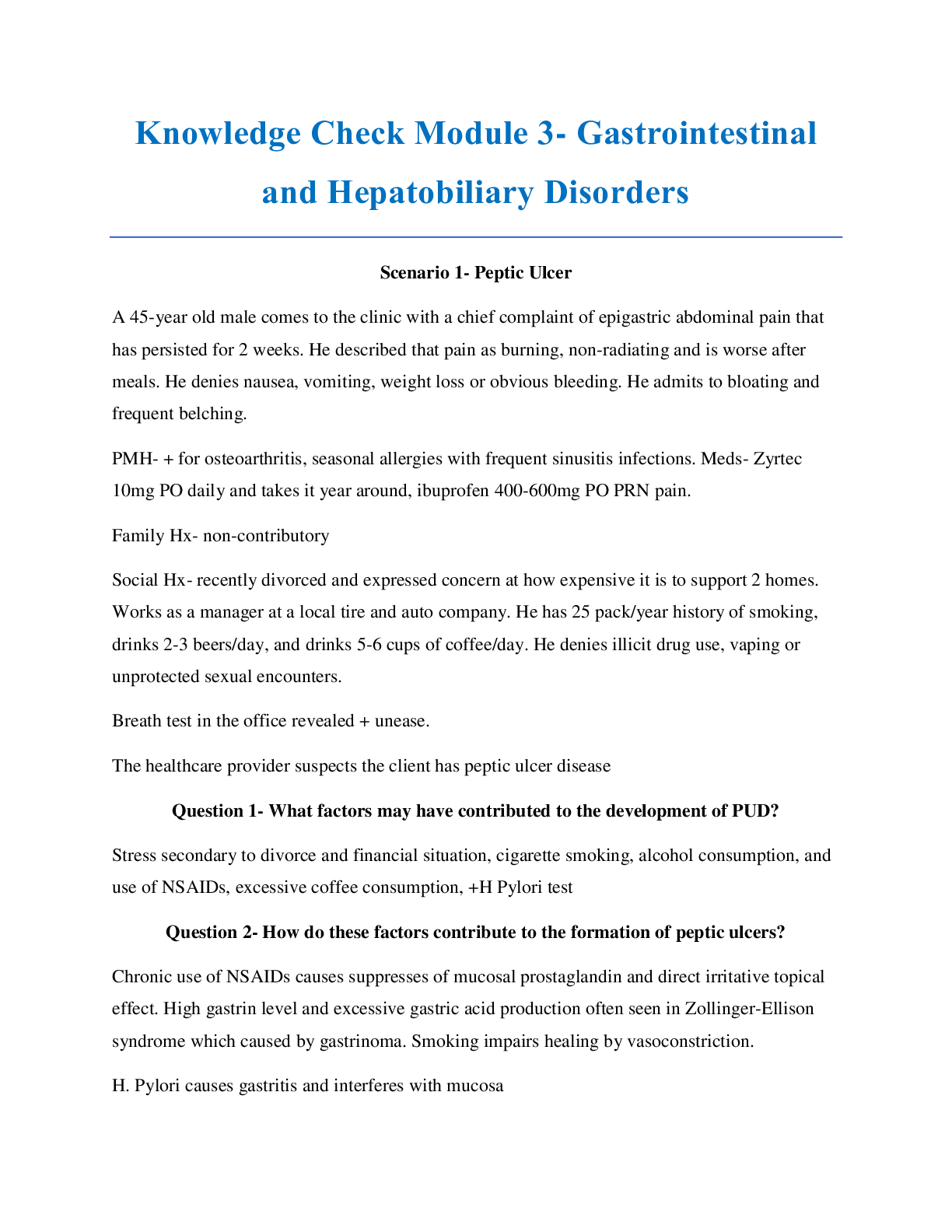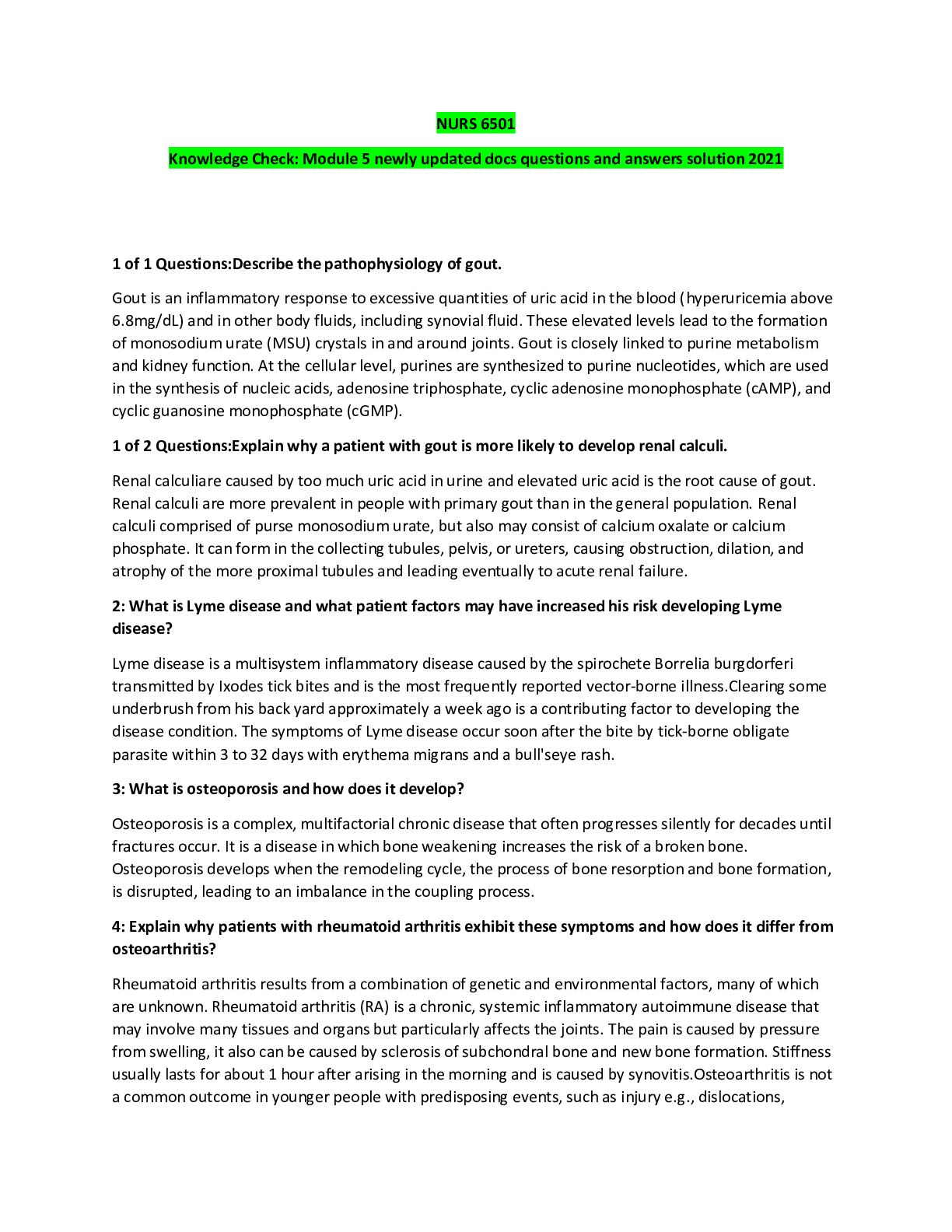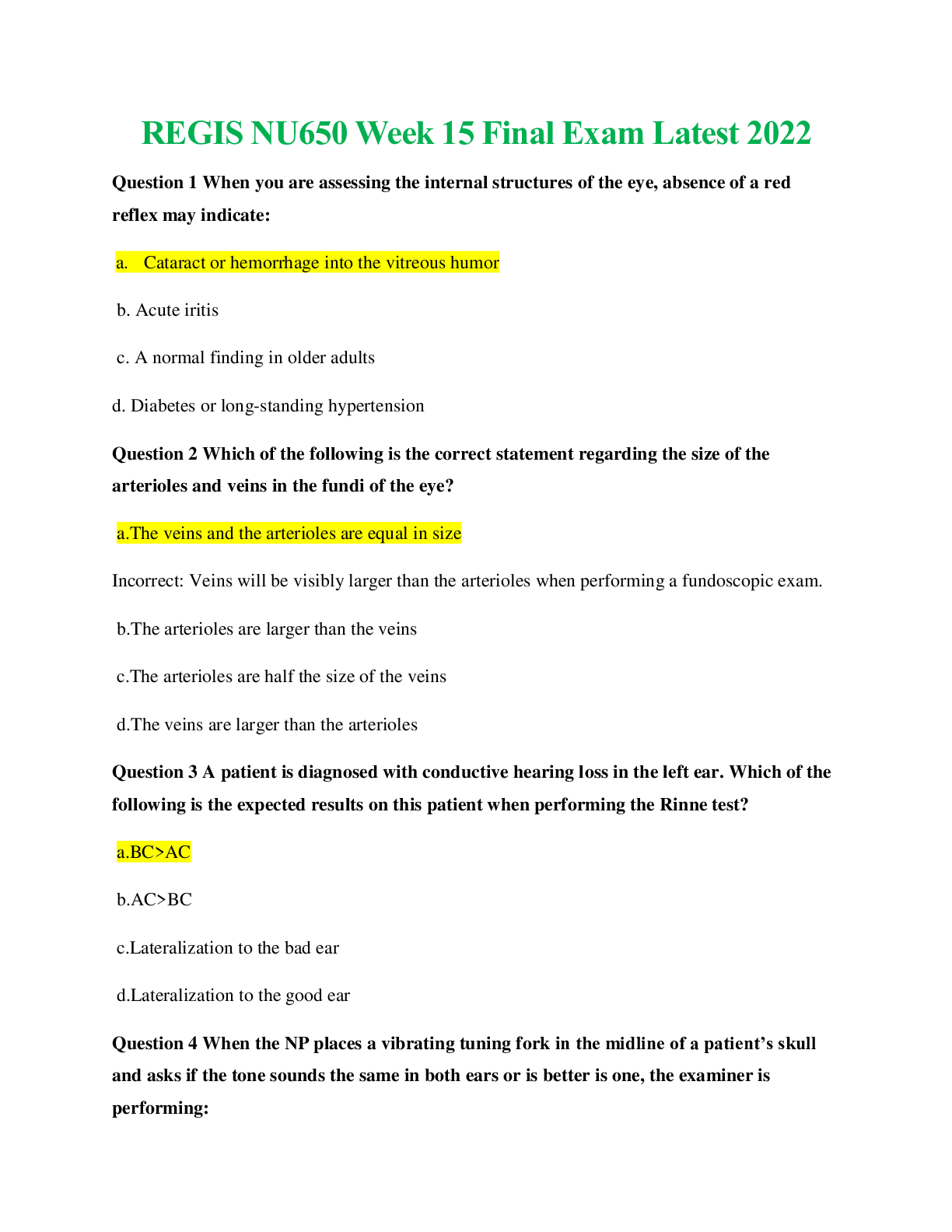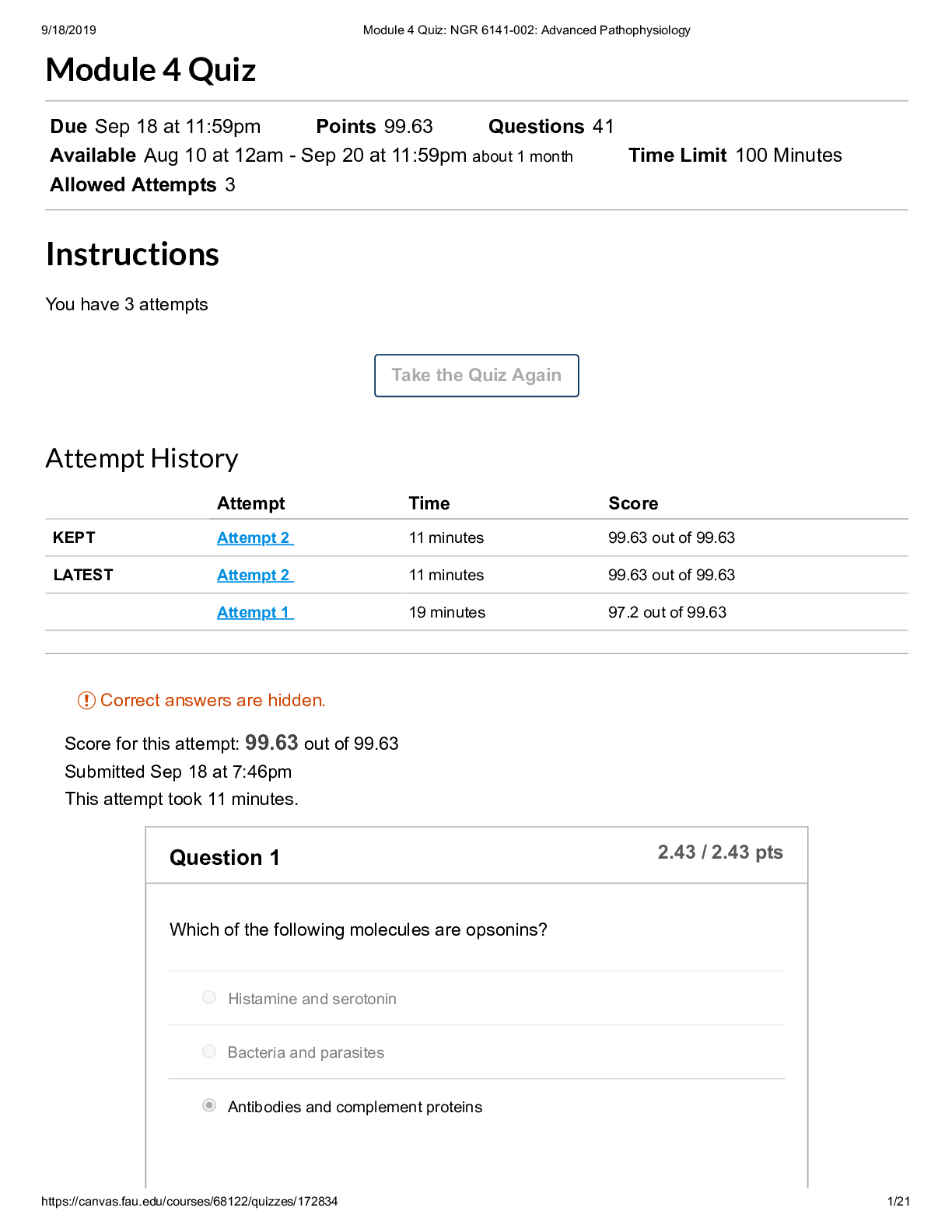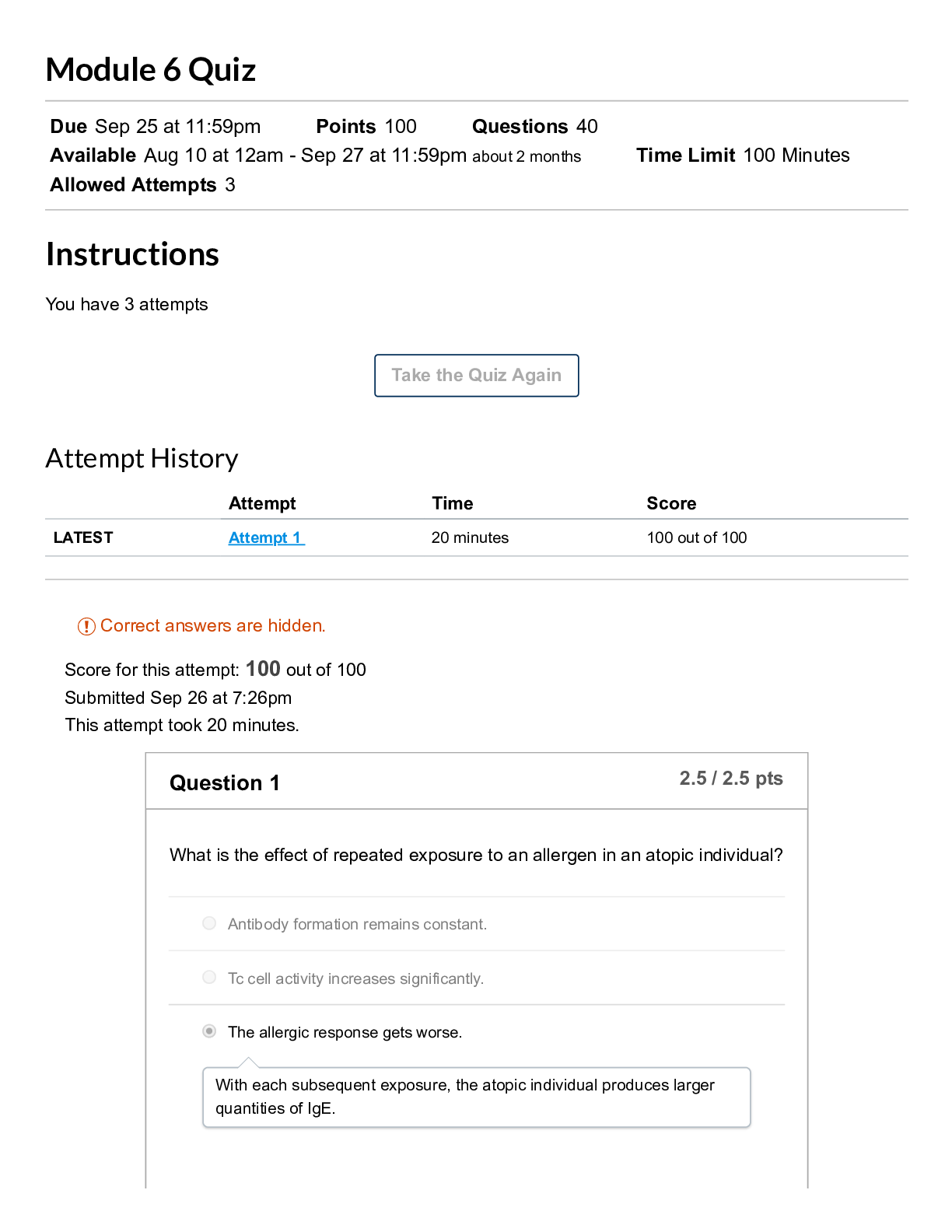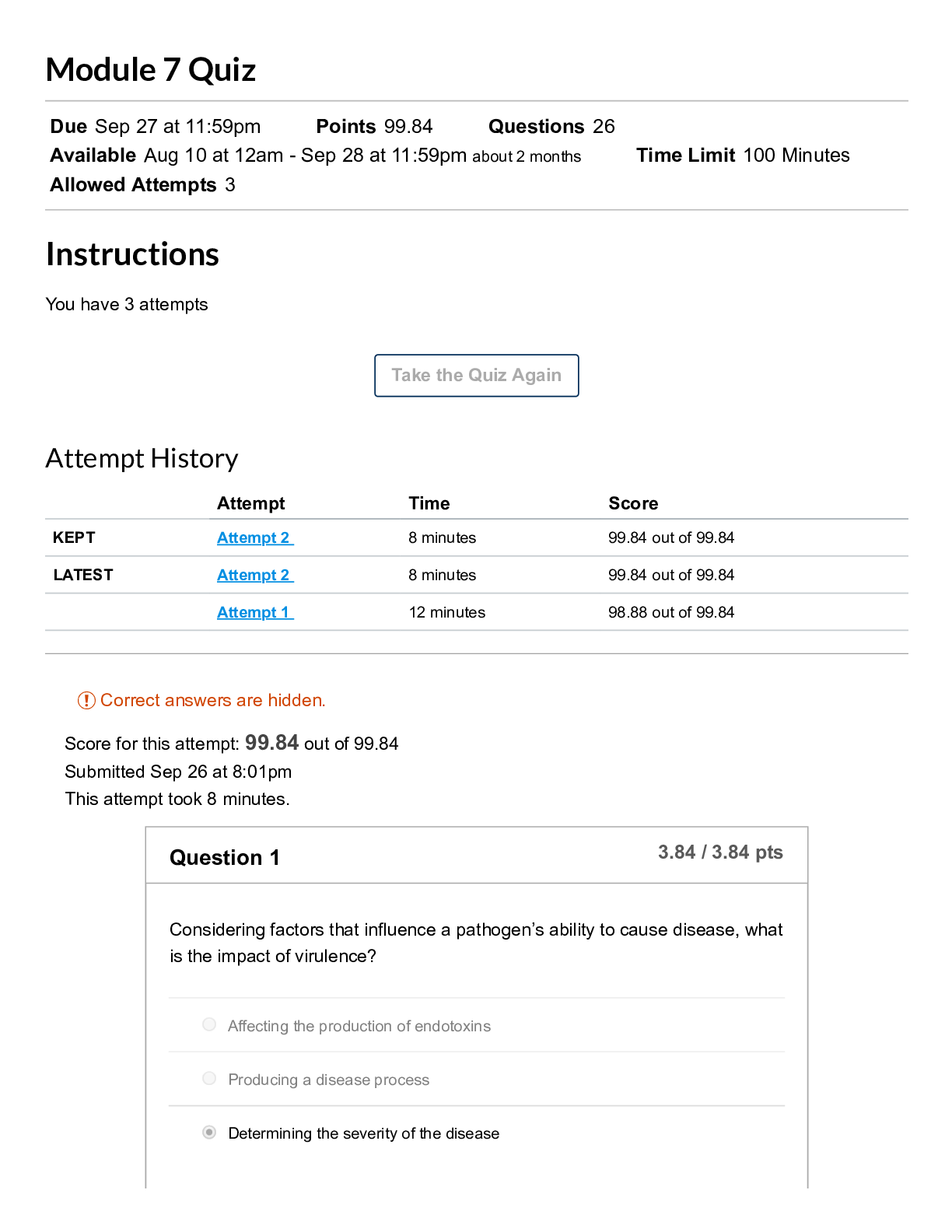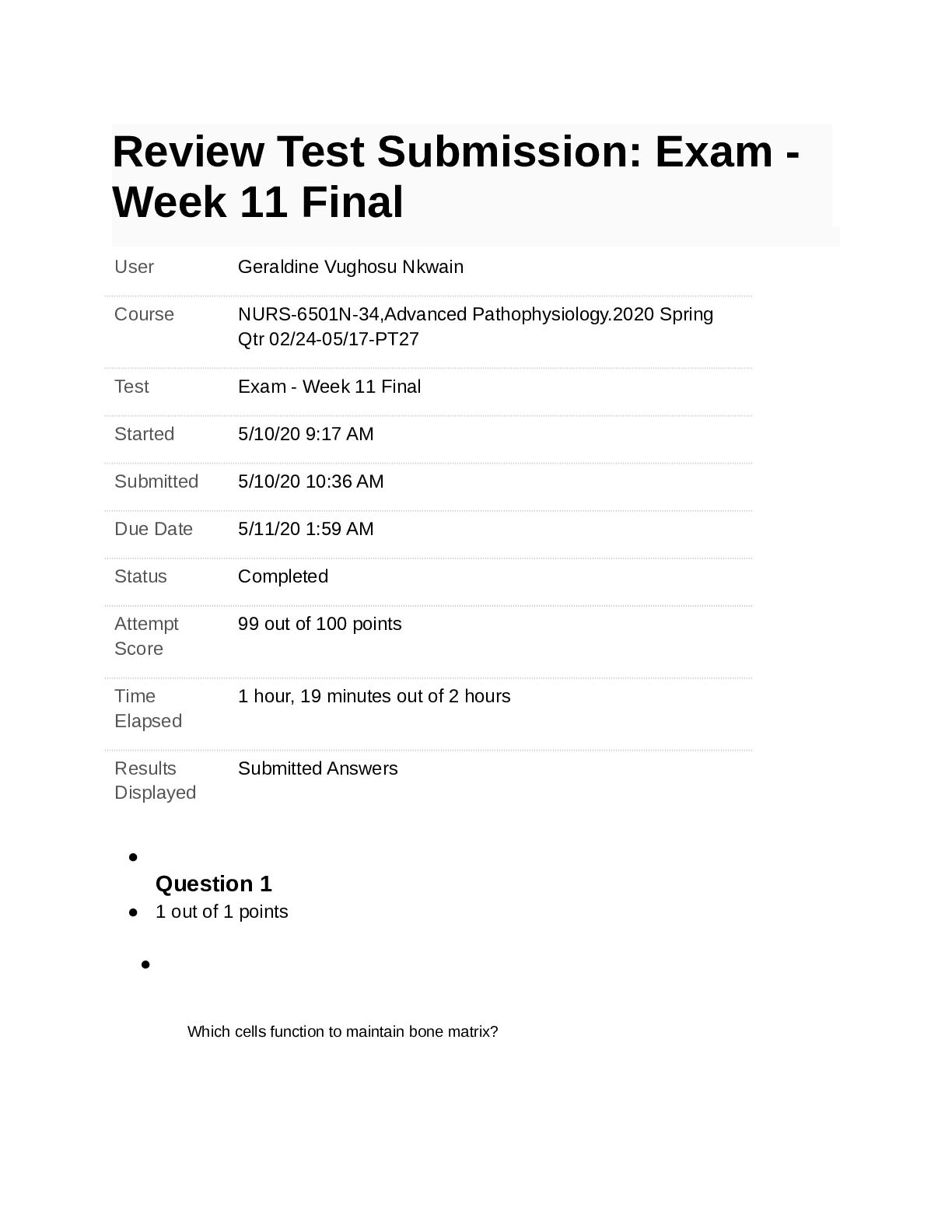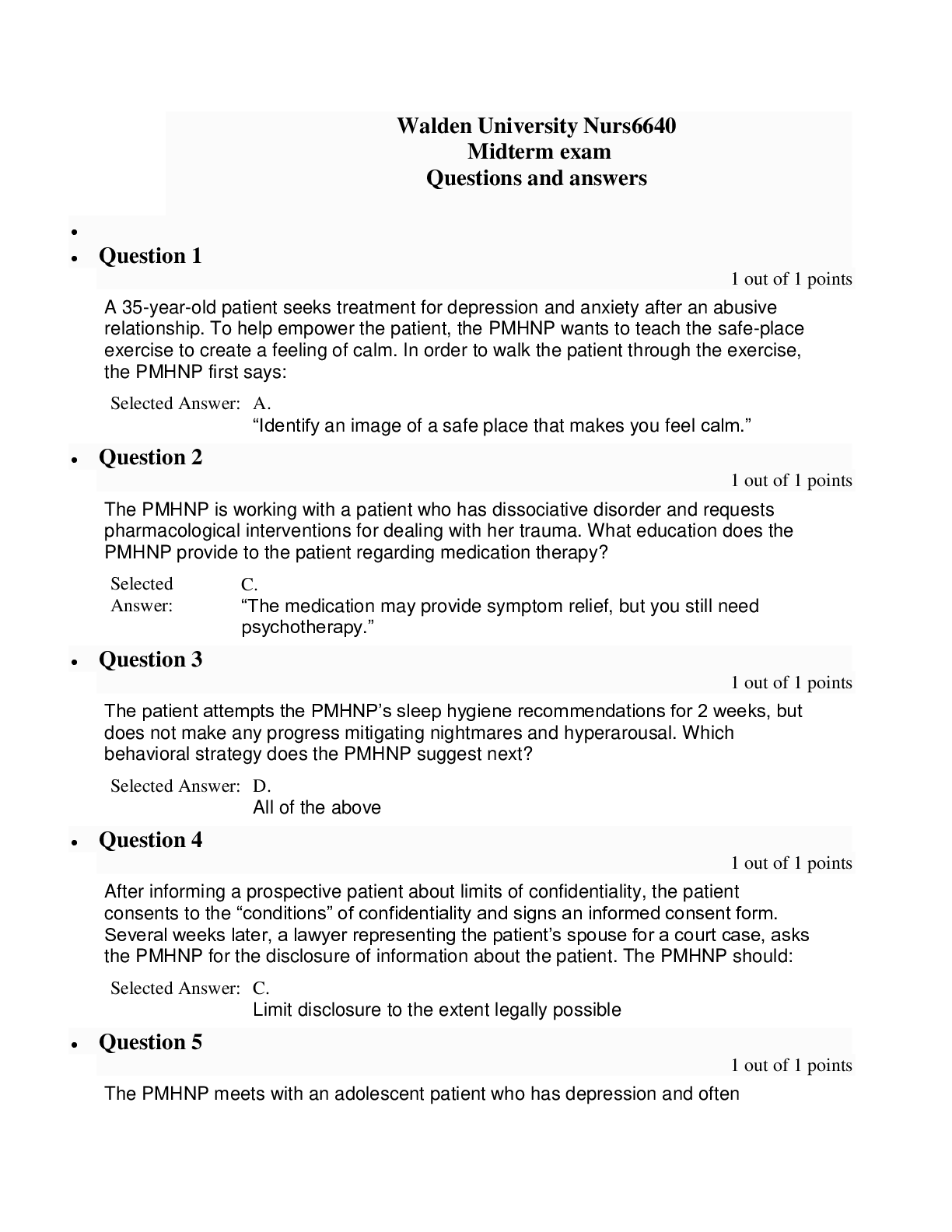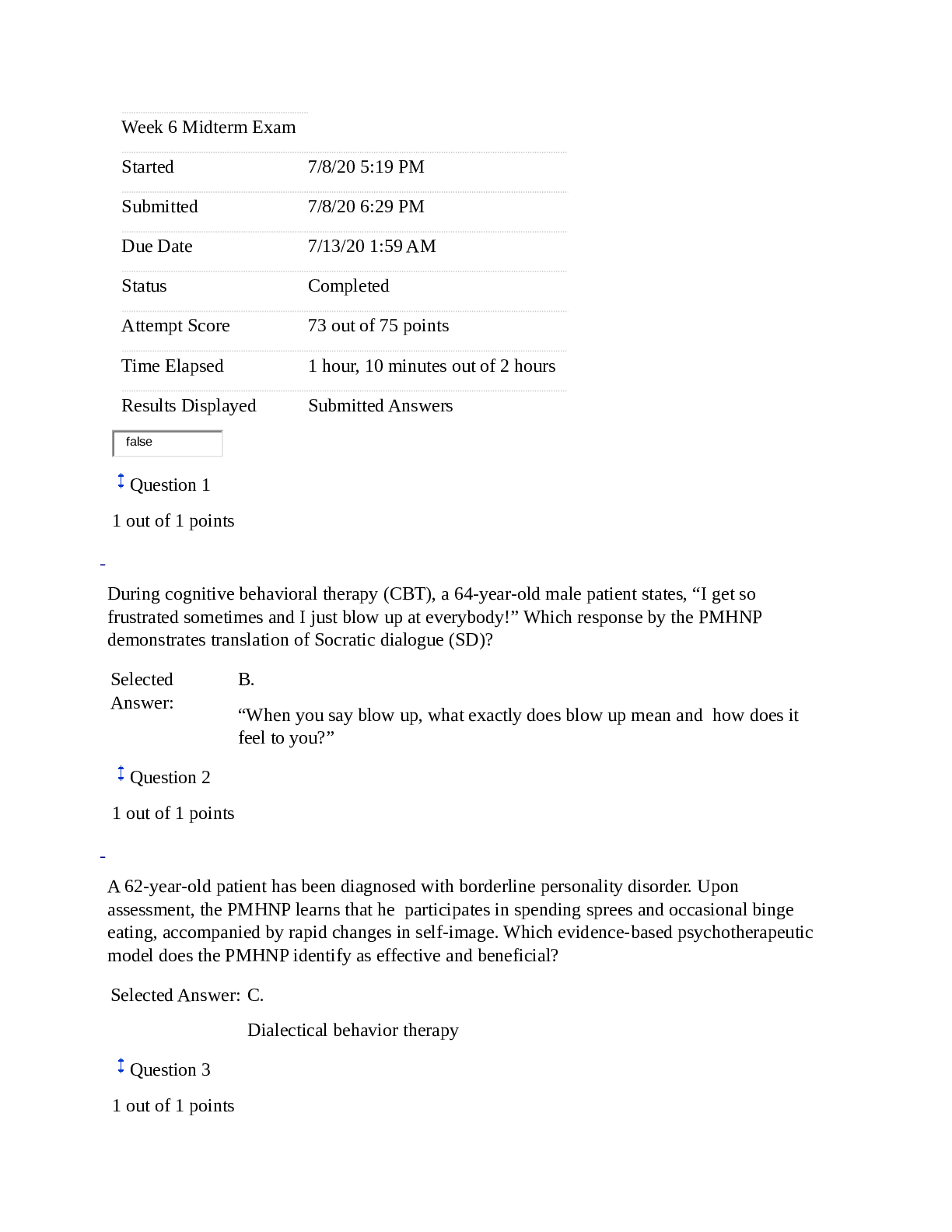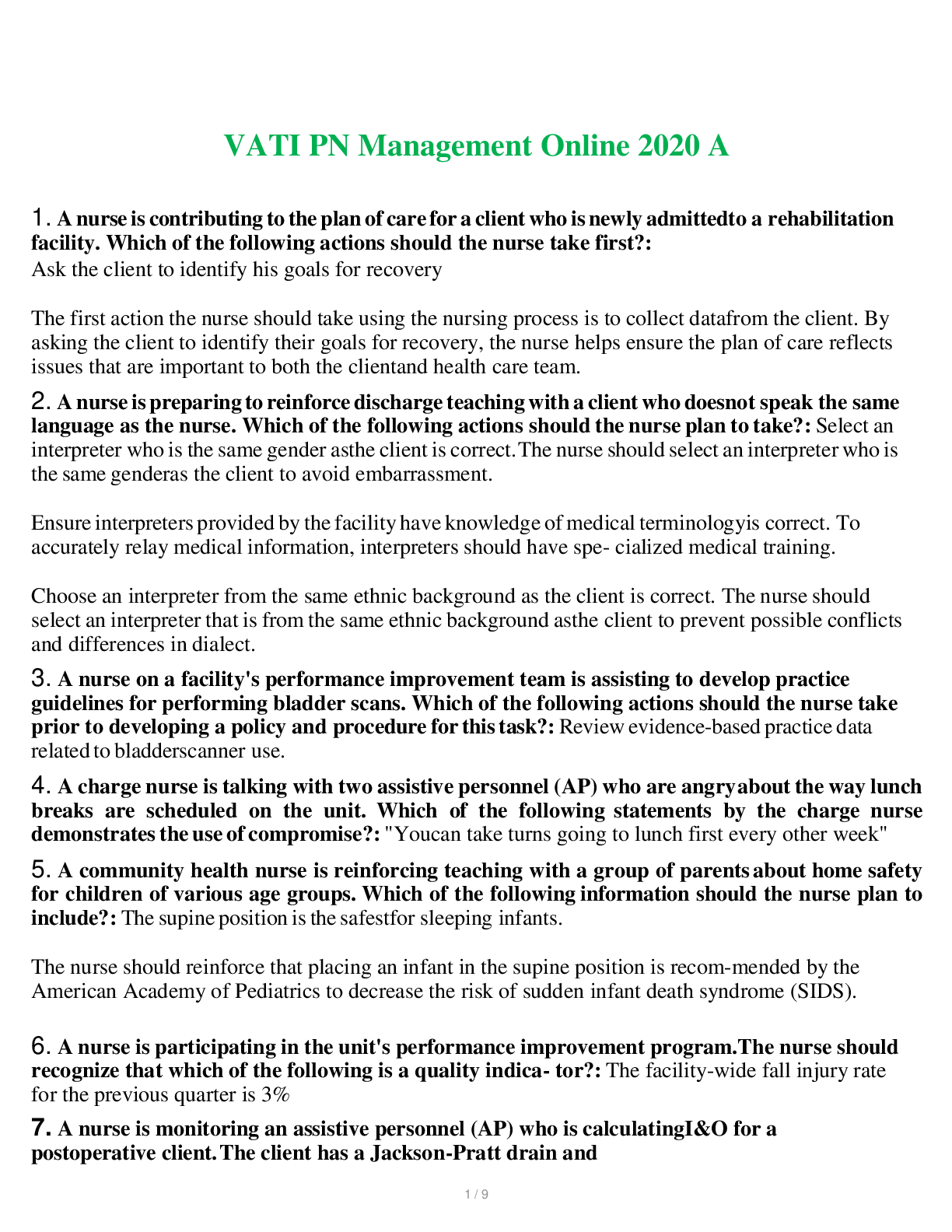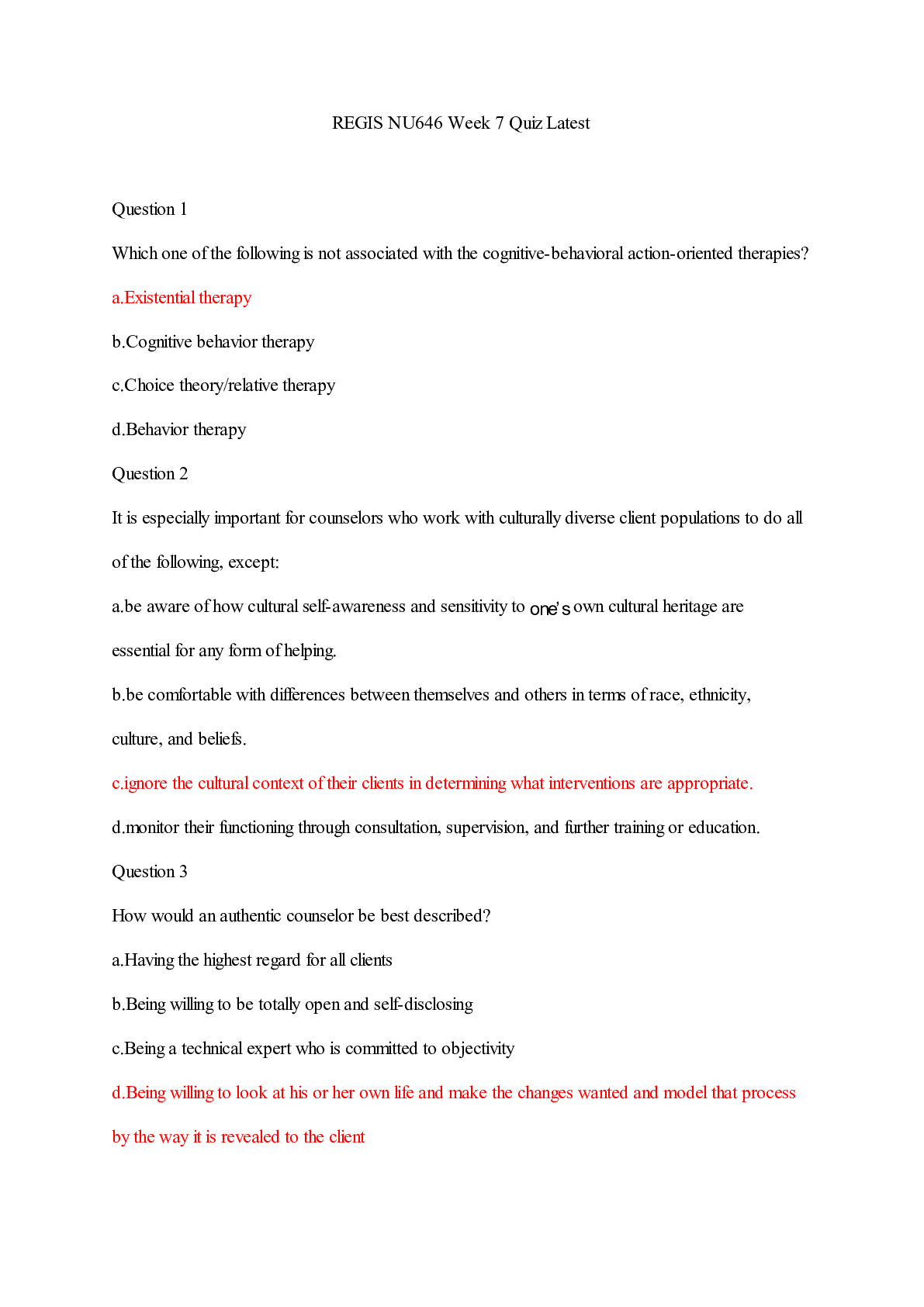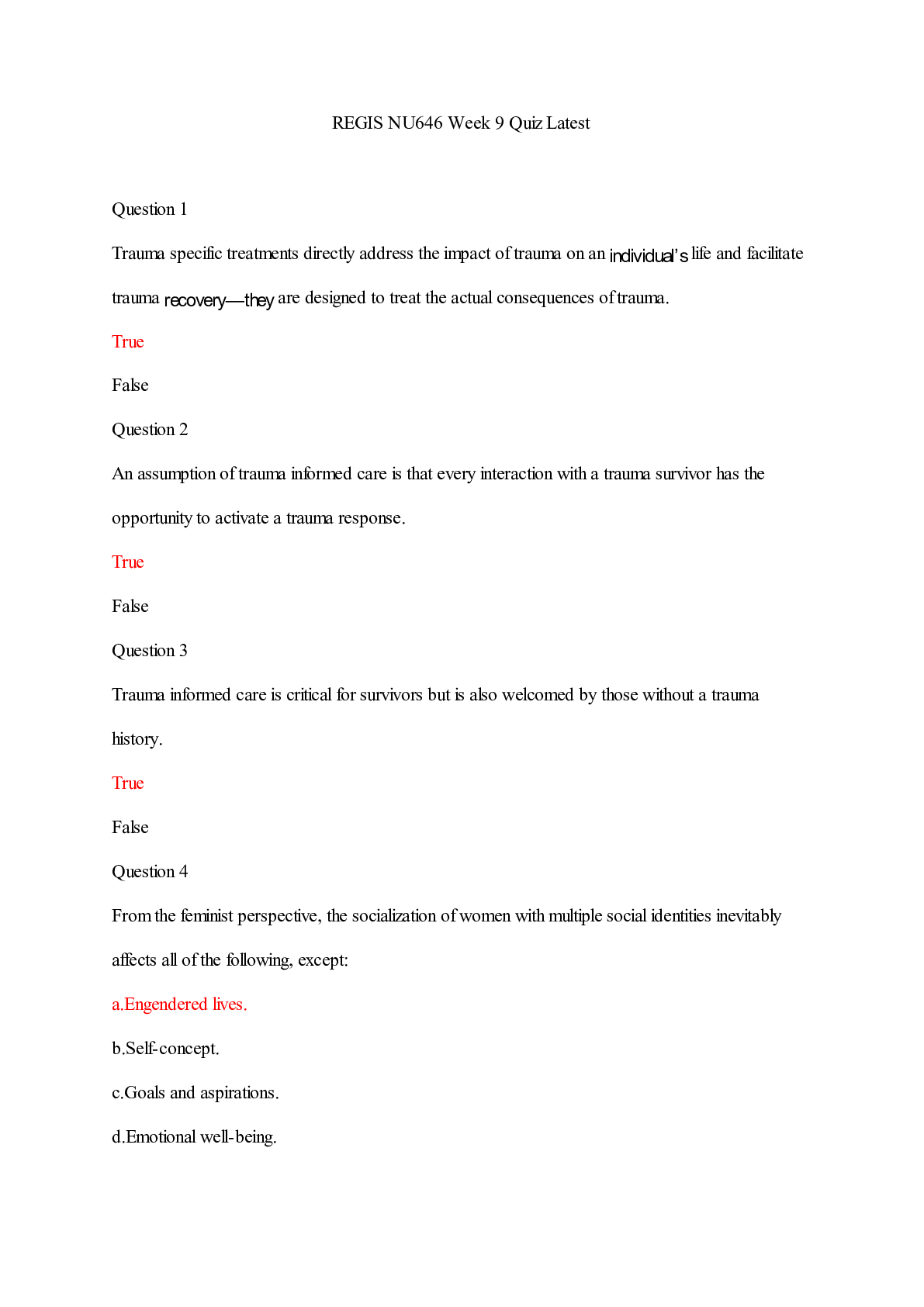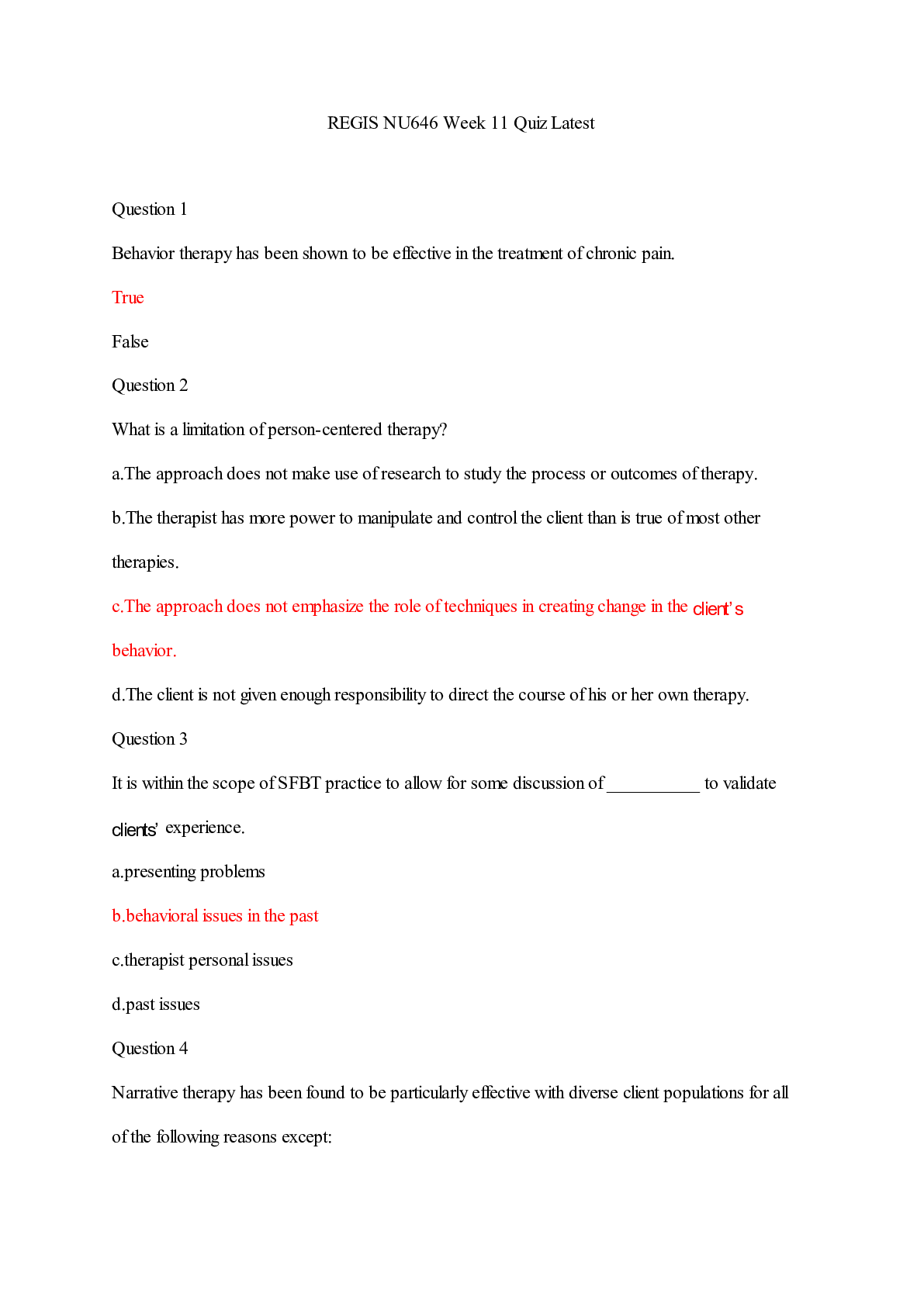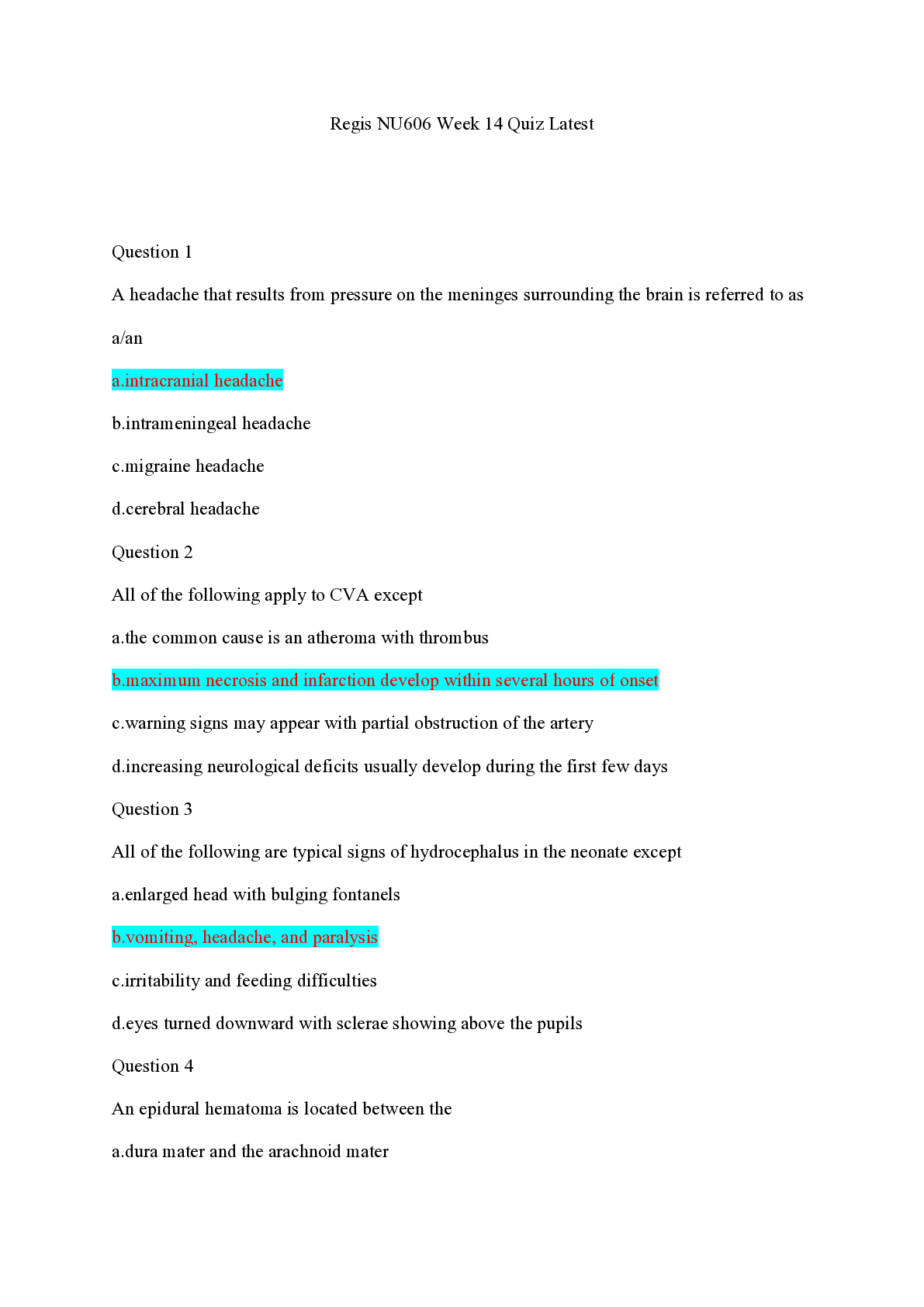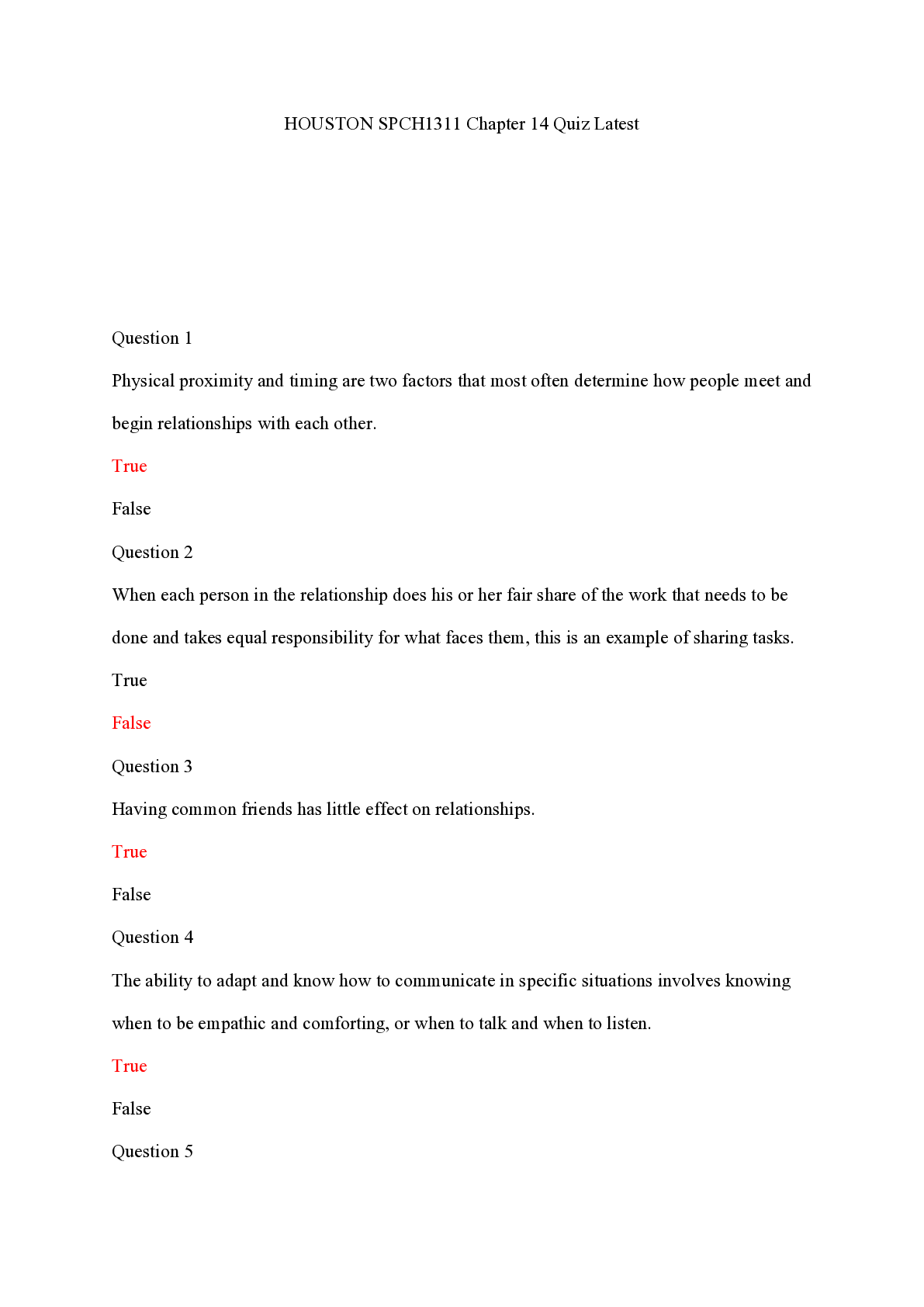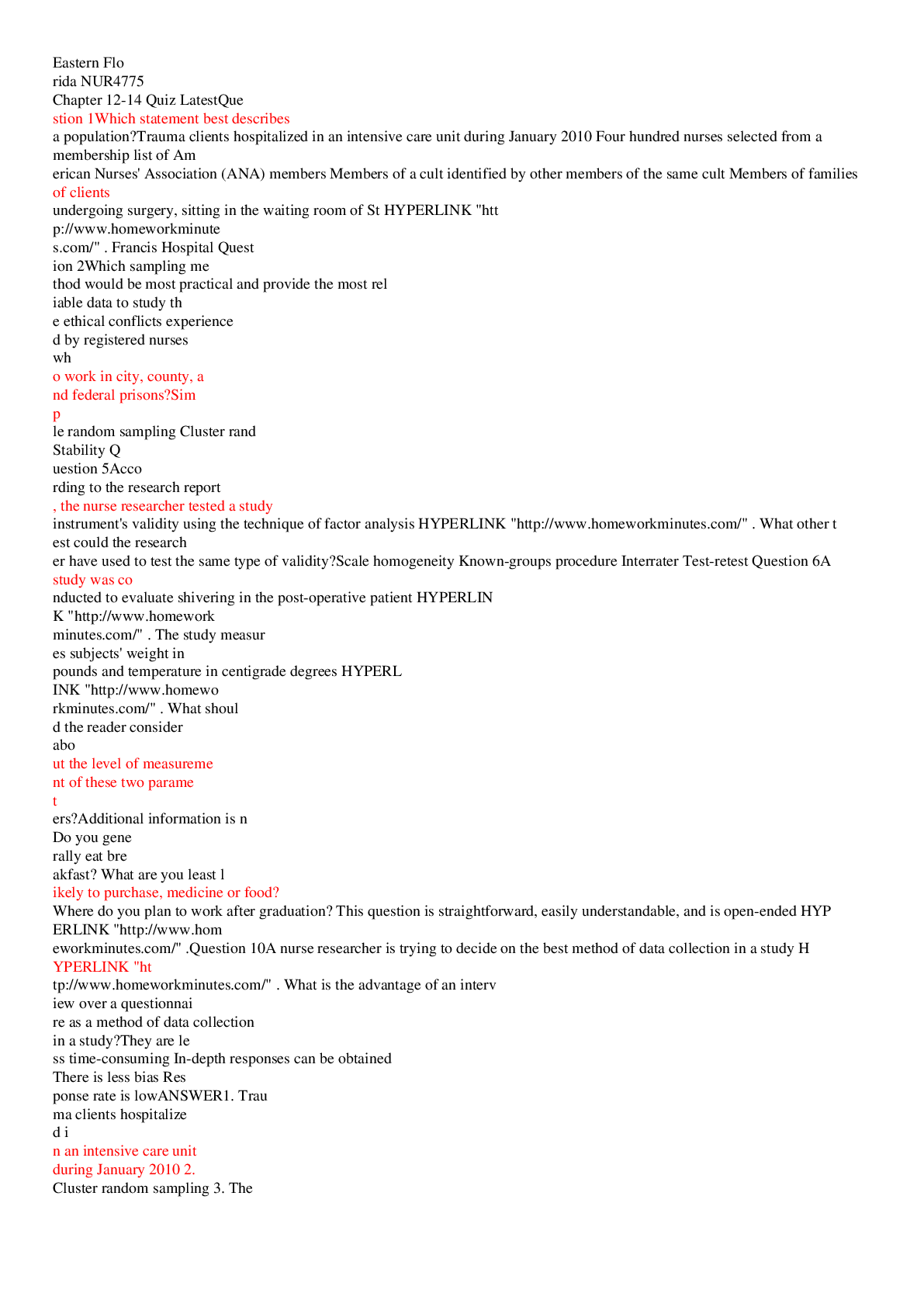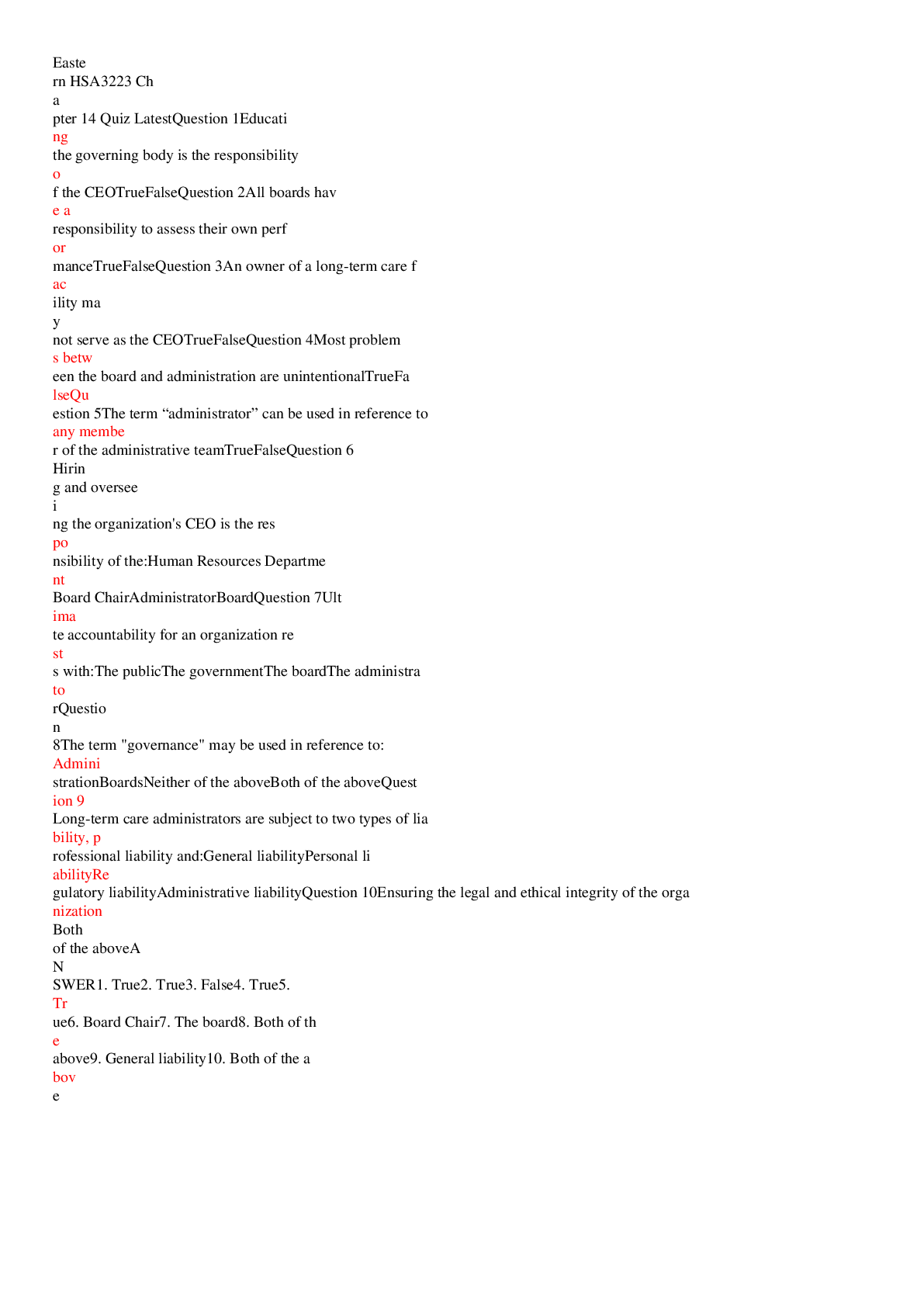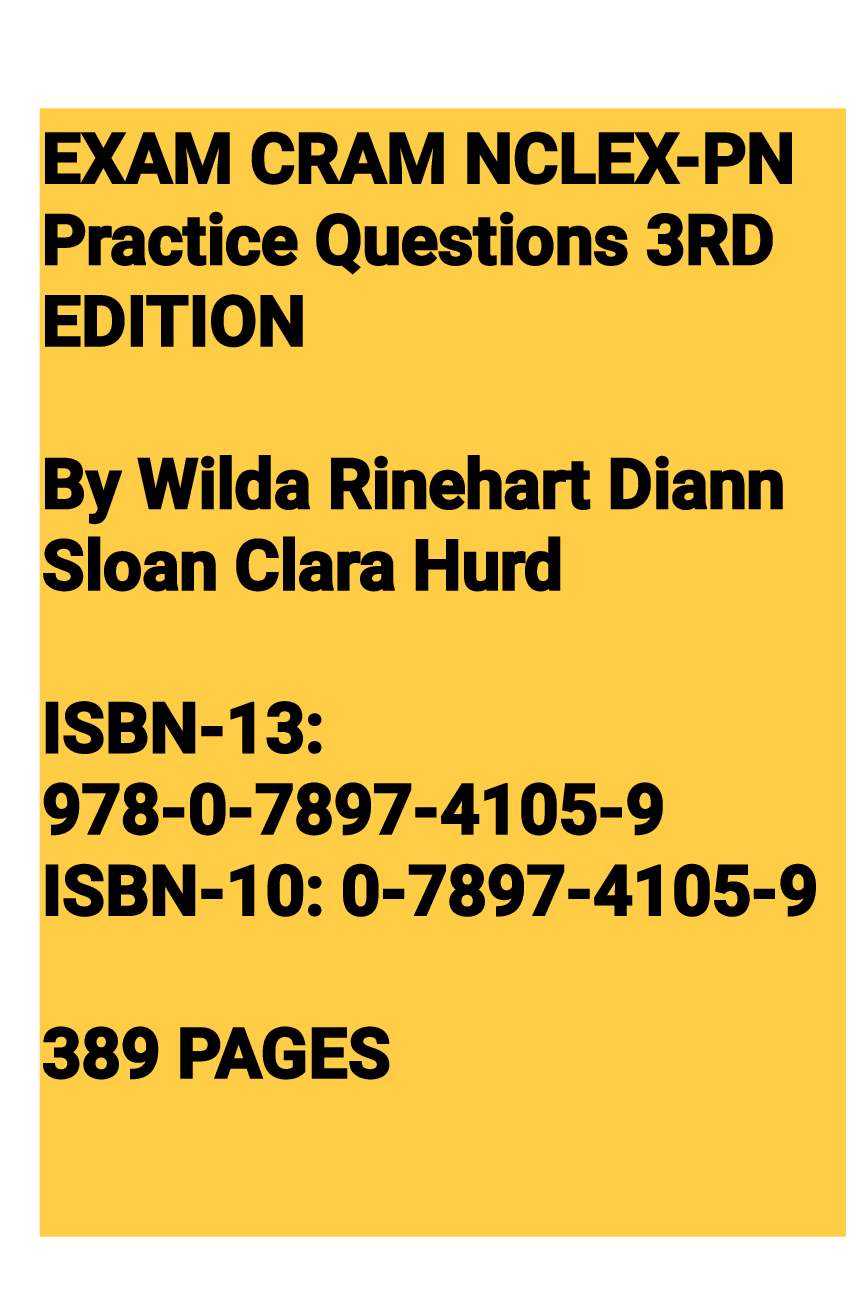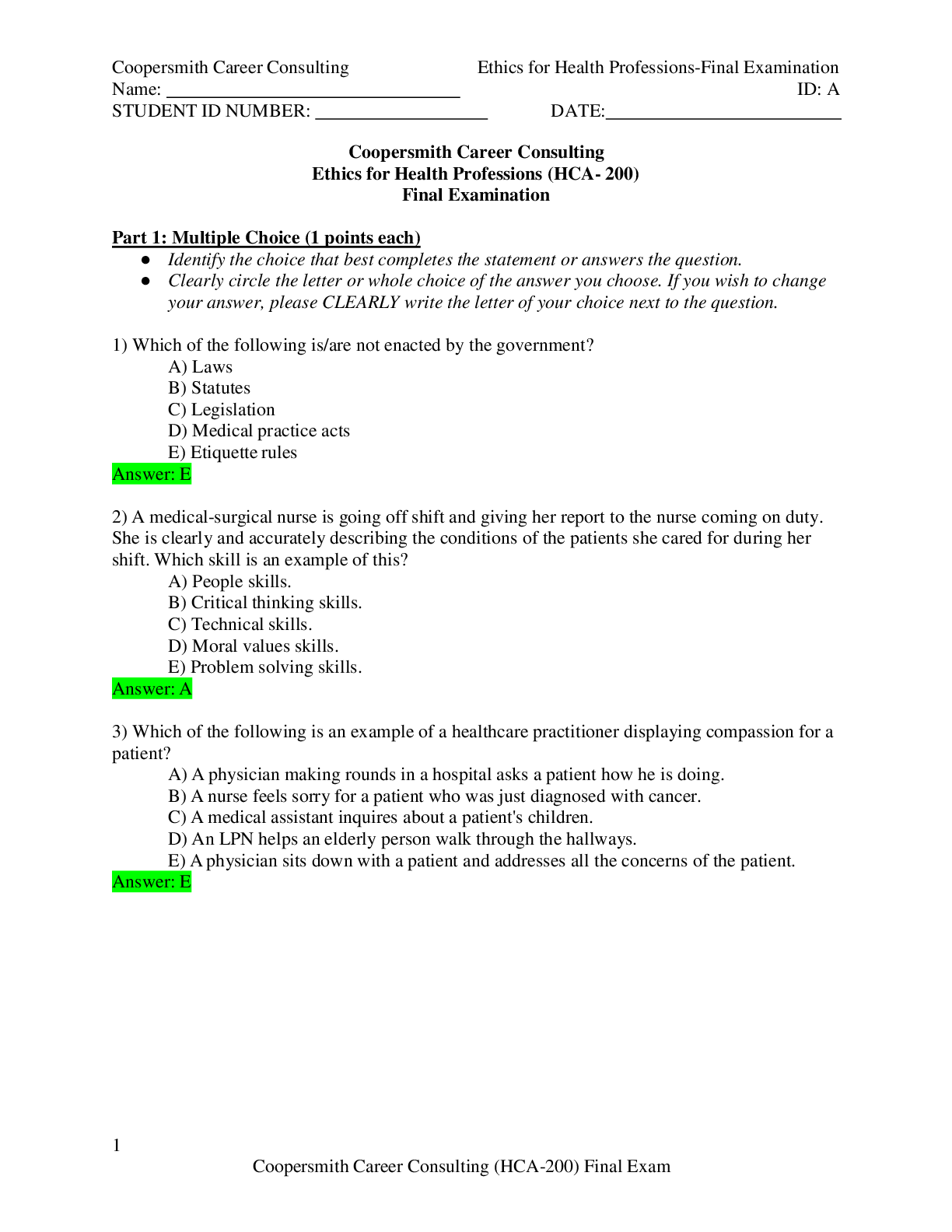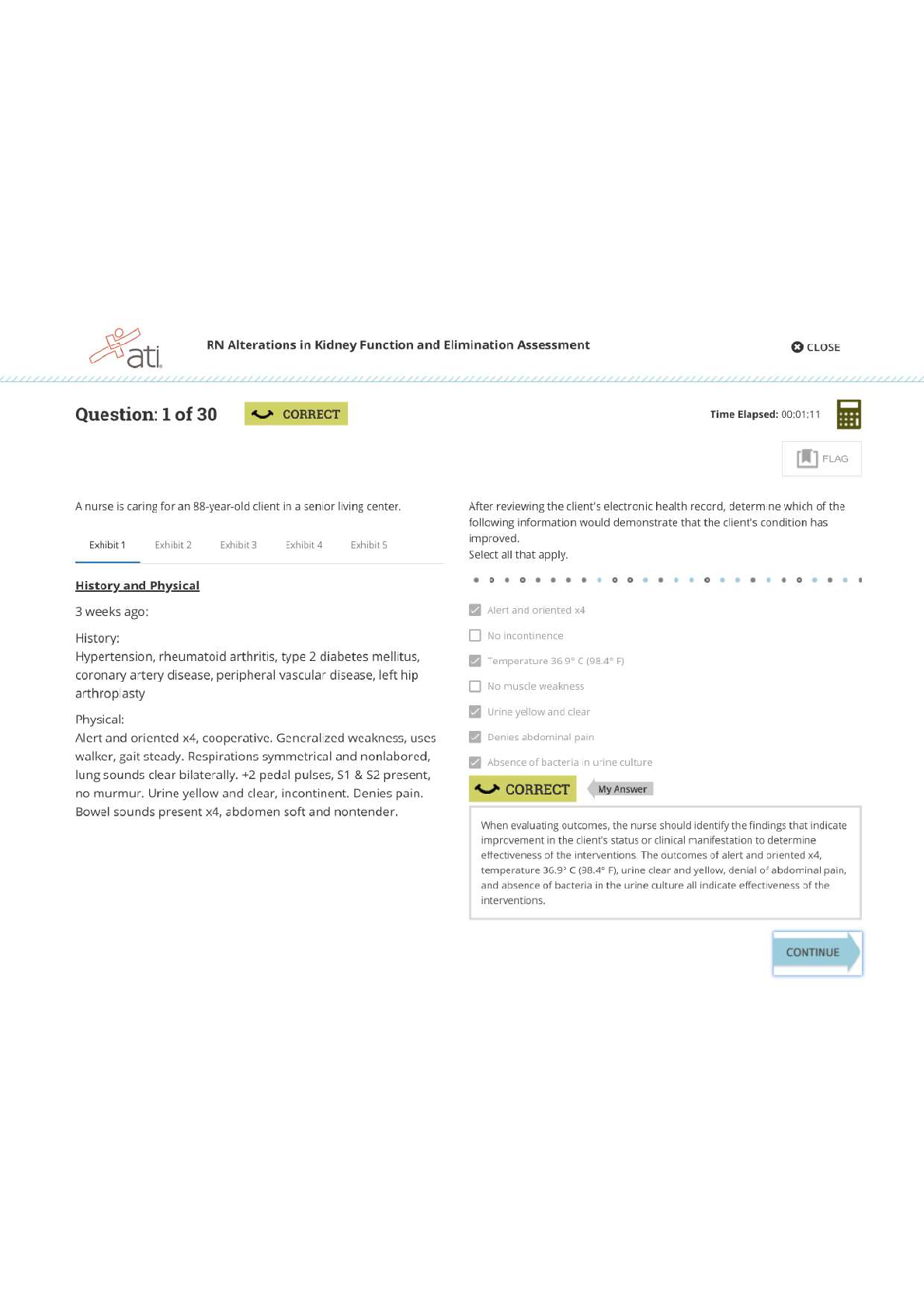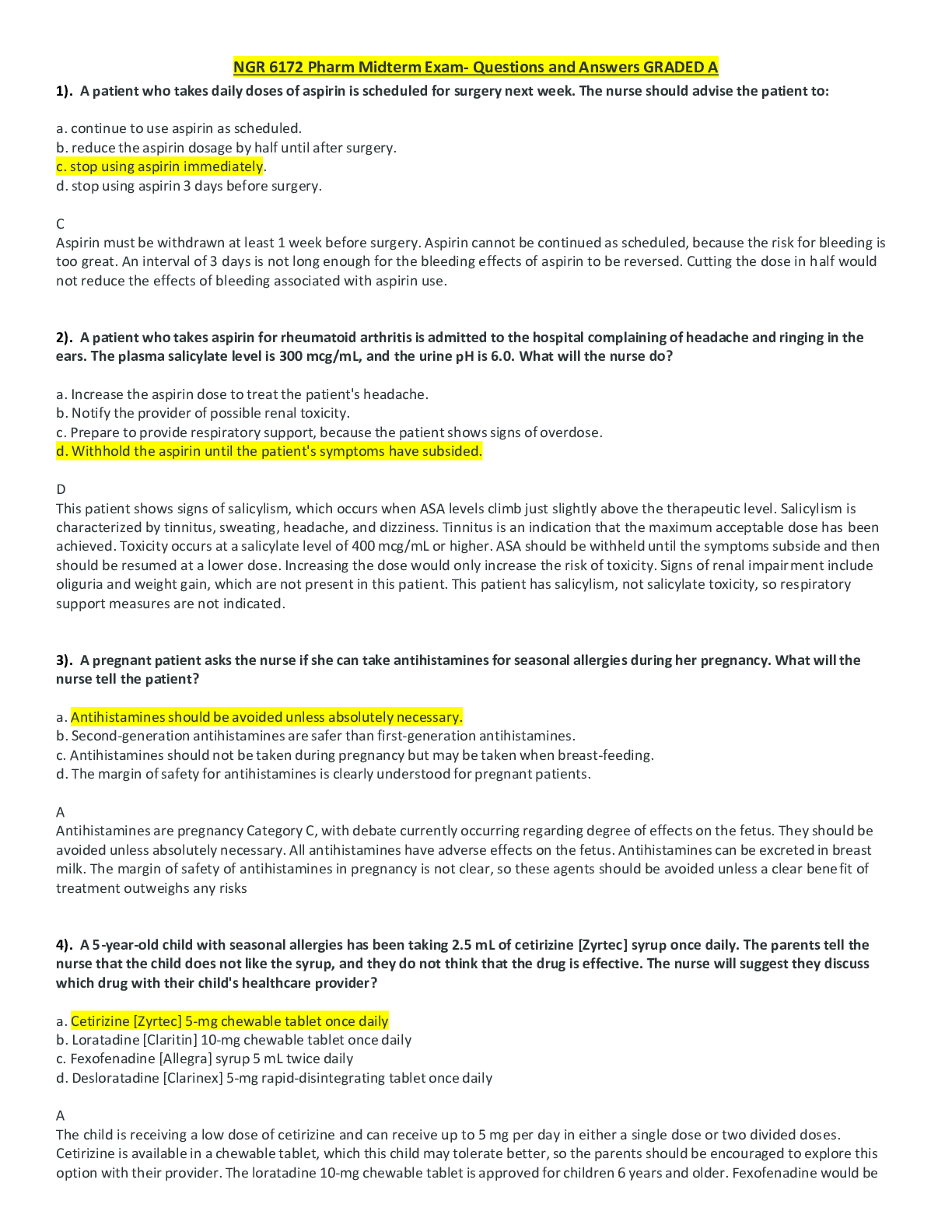*NURSING > EXAM > REGIS NU646 Week 14 Quiz Latest (39 questions) /REGIS NU646 Week 14 Quiz Latest (39 questions) (All)
REGIS NU646 Week 14 Quiz Latest (39 questions) /REGIS NU646 Week 14 Quiz Latest (39 questions)
Document Content and Description Below
REGIS NU646 Week 14 Quiz Latest HERE IS A LIST OF THE QUESTIONS Question 1 The cognitive distortion of making conclusions without supporting and relevant evidence is: a.labeling and mislabeling. ... b.overgeneralization. c.arbitrary inferences. d.selective abstraction. Question 2 The cognitive distortion that consists of forming conclusions based on an isolated detail of an event is: a.labeling and mislabeling. b.overgeneralization. c.arbitrary inferences. d.selective abstraction. Question 3 The tendency for individuals to relate external events to themselves, even when there is no basis for making this connection, is known as: a.labeling and mislabeling. b.overgeneralization. c.arbitrary inferences. d.personalization. Question 4 The cognitive distortion that involves portraying one’sidentity on the basis of imperfections and mistakes made in the past and allowing them to define one’strue identity is:a.labeling and mislabeling. b.overgeneralization. c.arbitrary inferences. d.personalization. Question 5 What is the challenge of fulfilling the spirit of informed consent? a.Tell clients about the nature of confidentiality. b.Strike a balance between giving clients too much information and giving them too little. c.Convince clients that counselors know what they are doing. d.Teach clients about state laws that pertain to counseling. Question 6 The ethics codes do not mandate that dual or multiple relationships a.should be avoided or that nonsexual multiple relationships are unethical. b.are clearly grounds for revocation of one’sprofessional license. c.are helpful in case of counseling one’sfriends or relatives. d.are impossible to avoid. Question 7 Identify the only case in which confidentiality must not be breached. a.Clients pose a danger to others. b.A child under the age of 16 requests counseling sessions. c.An older adult is being abused. d.The therapist determines that the client needs immediate, involuntary hospitalization. Question 8 The technique whereby the analyst explains the meaning of certain behavior is known asa.transference. b.rationalization. c.countertransference. d.interpretation. Question 9 Directing energy toward another object or a person (when anxiety is reduced by focusing on a “safer target”) is known as a.sublimation. b.repression. c.introjection. d.displacement. Question 10 What is the correct sequence of the psychosexual stages? a.Anal/phallic/latency/genital/oral b.Oral/anal/phallic/latency/genital c.Oral/anal/latency/genital/phallic d.Latency/oral/anal/phallic/genital Question 11 In Erikson’sview, the major developmental task in adolescence is a.intimacy versus isolation. b.integrity versus despair. c.identity versus role confusion. d.initiative versus guilt. Question 12According to Erickson, the basic struggle of early childhood involves: a.autonomy vs. shame and doubt. b.initiative vs. guilt. c.identity vs. role confusion. d.trust vs. mistrust. Question 13 A person who is suffering from feelings of alienation and isolation has probably failed to achieve a sense of ___________ during the ___________stage of development. a.identity; adolescence b.trust; infancy c.generativity; middle age d.intimacy; young adulthood Question 14 Developmentally, Freud’slatency stage corresponds to Erickson’sstage of: a.trust versus mistrust. b.intimacy versus isolation. c.initiative versus guilt. d.industry versus inferiority. Question 15 One point of disagreement between existential and humanistic thought involves a.a respect for the client’ssubjective experience. b.a trust in the capacity of the client to make positive choices. c.an emphasis on freedom. d.the idea of an innate self-actualizing drive.Question 16 From a person-centered perspective, the best source of knowledge about the client is the a.individual client. b.therapist. c.client's family. d.therapeutic relationship. Question 17 The cognitive behavioral approach to therapy stresses: a.support, understanding, warmth, and empathy. b.awareness, unfinished business, impasse, and experiencing. c.thinking, assessing, deciding, analyzing, and doing. d.subjectivity, existential anxiety, self-actualization, and being. Question 18 In cognitive therapy, techniques are designed to: a.assist clients in substituting rational beliefs for irrational beliefs. b.help clients experience their feelings more intensely. c.assist individuals to dispel self-defeating cognitions and to teach people how to acquire a rational approach to living. d.enable clients to deal with their existential loneliness. Question 19 According to Beck, selective abstraction is clients taking all the details of an event and using this information to reinforce negative schemas and support their maladaptive core beliefs. True FalseQuestion 20 Magnification and minimization consist of perceiving a case or situation in a greater or lesser light than it truly deserves. True False Question 21 From the feminist perspective, the socialization of women with multiple social identities inevitably affects all of the following, except: a.engendered lives. b.self-concept. c.goals and aspirations. d.emotional well-being. Question 22 Which of the following themes would clients in feminist therapy be least likely to explore? a.Identify their internalized messages of oppression and replace them with more self-enhancing beliefs b.Understand how sexist and oppressive societal beliefs and practices influence them in negative ways c.Recognize the power of relationships and connectedness d.Transference reactions toward their therapist Question 23 The feminist approach to group counseling involves all of the following except: a.support for the experience of being a woman. b.political involvement.c.providing members a place to reflect on their role in society. d.an opportunity to experience and analyze multiple transferences. Question 24 Donna feels certain that no one will ever want to hire her because she has a timid personality. Her solution-oriented therapist would be most inclined to: a.explore her early childhood experiences with being rejected b.consider her irrational belief to be indicative of psychopathology. c.ask Donna to examine another side of the story she is presenting about herself and think of times when she was accepted by others. d.prescribe medication for her anxiety issues. Question 25 All of the following are techniques used in solution-focused therapy except for: a.using the reflecting team. b.scaling questions. c.the miracle question. d.formula first session task. Question 26 Narrative therapy has been found to be particularly effective with diverse client populations for all of the following reasons except: a.it was founded in a sociocultural context. b.it allows clients to tell their unique stories from their perspective. c.it defines problems within a social, cultural, political, and relational context. d.it teaches diverse clients to replace their own narratives with ones that conform more closely to the ideals and values of mainstream culture.Question 27 The techniques of externalization and developing unique events are associated primarily with: a.solution-oriented therapy. b.the linguistic approach. c.the narrative approach. d.the reflecting team. Question 28 Narrative therapists pay attention to “sparklingmoments,” such as a.moments when the client feels exhilarated. b.identifying instances when the problem did not completely dominate the client’slife. c.times when significant others give the client unconditional love. d.events characterized by a striving to overcome barriers. Question 29 During the solution-focused initial therapy session, it is common for solution-focused therapists to ask, “What have you done since you called for the appointment that has made a difference in your problem?” This describes: a.formula first session task. b.the miracle question. c.pretherapy change. d.exception questions. Question 30 Solution-focused brief therapy has parallels with______________, which concentrates on what is right and what is working for people rather than dwelling on deficits, weaknesses, and problems. a.brief psychodynamic therapyb.positive psychology c.Adlerian therapy d.REBT Question 31 Family therapy perspectives call for a conceptual shift from evaluating individuals to focusing on: a.system dynamics. b.individual symptoms. c.the identified client only. d.an individual’sreactions. Question 32 An integrative approach to the practice of family therapy includes guiding principles that help the therapist organize all of the following, except: a.goals. b.interactions. c.observations. d.medications. Question 33 From the family systems perspective, symptoms are often viewed as a.an expression of a set of habits and patterns within a family. b.evidence of psychopathology. c.a sign of weakness. d.a result of cognitive distortions. Question 34 What is the technique in family therapy that casts a new light on a problem and provides a differentinterpretation for a problematic situation? a.Reorganization b.Family mapping c.Restructuring d.Reframing Question 35 A tool for collecting and organizing key relationships in a three-generational extended family is a a.lifestyle assessment. b.family sketch. c.genogram. d.projective test. Question 36 The one central principle agreed upon by family therapy practitioners, regardless of their particular approach, is that a.the client is connected to living systems. b.family dysfunction is typically caused by the most dominant family member. c.lack of differentiation is the primary cause of all family dysfunction. d.the empty chair technique is the most effective technique. Question 37 Roger and his wife are experiencing tension in their relationship because he believes she is far too lenient with their children when they misbehave. This forces him to play the role of “bad cop” as a parent, which makes him angry. A family therapist working with Roger and his family might a.help to modify the family’stransactional rules and develop more appropriate boundaries. b.refer Roger to individual therapy since he clearly needs to work through his unresolved issues thatare causing him to feel so angry. c.take Roger’sside and educate his wife about appropriate disciplinary practices. d.focus on getting the children to stop misbehaving so that Roger and his wife won’t experience this tension. Question 38 To prevent his parents from leaving the house, Miguel throws temper tantrums. His parents have given in to his demands and never go out to dinner or to movies anymore. A structural-strategic therapist working with Miguel and his parents will most likely a.have them participate in an enactment during the therapy session. b.explain with a genogram the origins of Miguel's temper tantrums. c.help Miguel’sparents to develop differentiated selves. d.do a lifestyle assessment. Question 39 If we hope to work therapeutically with an individual, it is critical to consider him or her within the a.problematic system. b.behavioral system. c.individual system. d.family system. [Show More]
Last updated: 1 year ago
Preview 1 out of 12 pages
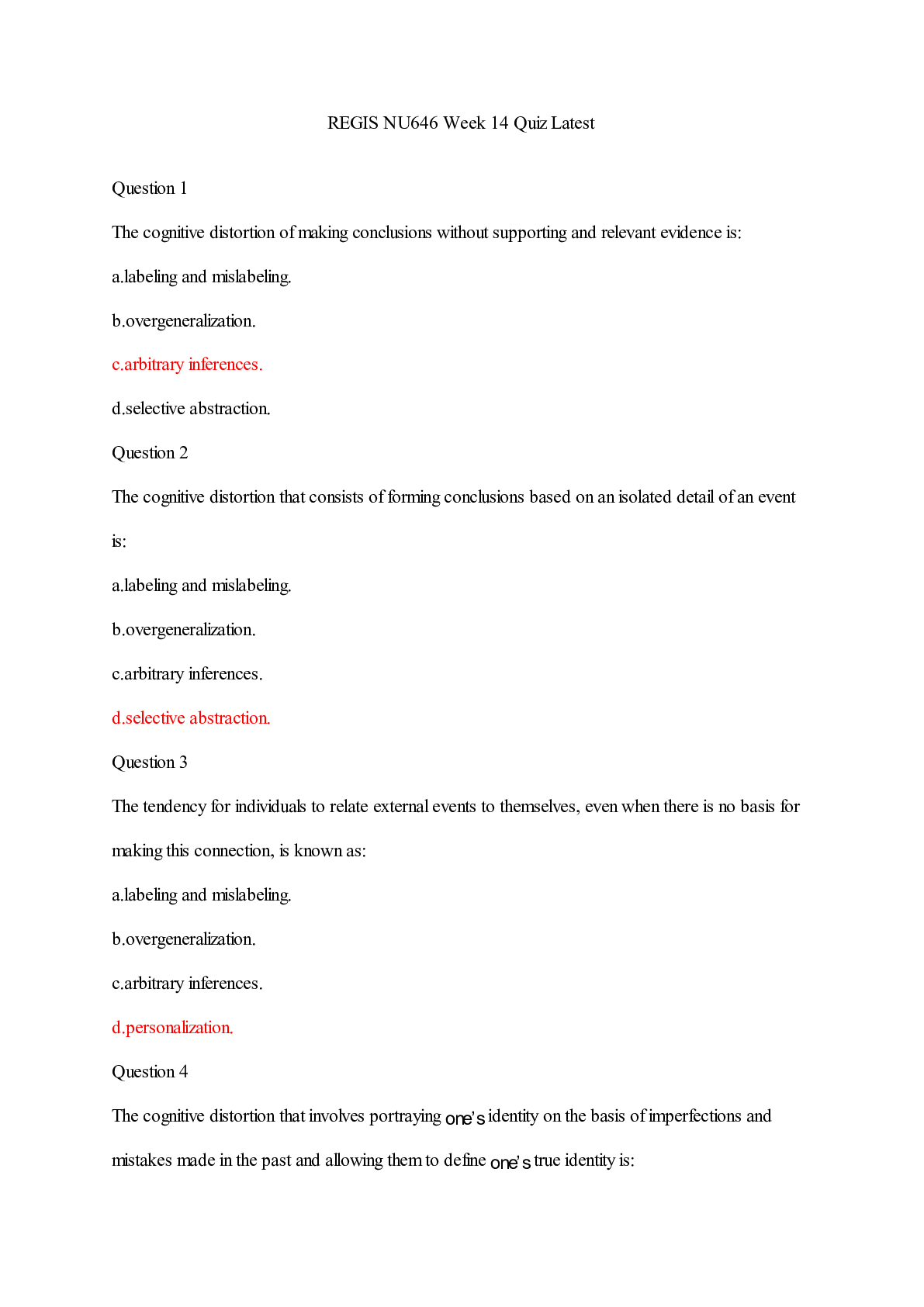
Reviews( 0 )
Document information
Connected school, study & course
About the document
Uploaded On
Mar 25, 2022
Number of pages
12
Written in
Additional information
This document has been written for:
Uploaded
Mar 25, 2022
Downloads
3
Views
173

